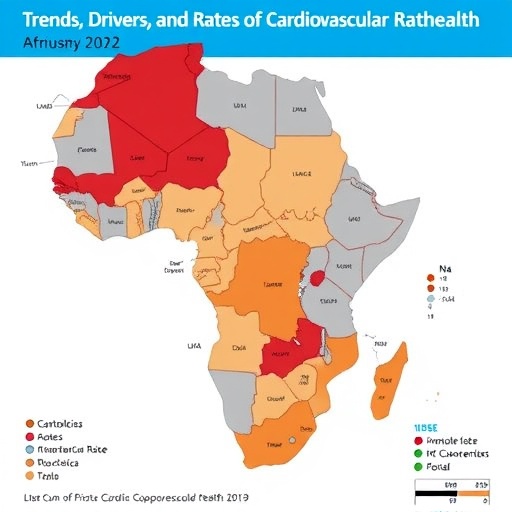A Comprehensive Analysis Unveils Cardiovascular Health Dynamics Across Africa: Insights from WHO STEPS Surveys
Cardiovascular diseases (CVD) remain a leading cause of morbidity and mortality worldwide, yet their impact across the World Health Organization (WHO) African Region has long been understudied in a cohesive, multi-national context. A groundbreaking situational analysis of WHO STEPS surveys from 22 countries within this region sheds new light on the cardiovascular health status dynamics at a population level. This study provides an unprecedented cross-sectional view, revealing actionable epidemiological patterns and determinants that hold the potential to transform public health strategies and policymaking aimed at stemming the rise of cardiovascular disease in Africa.
The WHO STEPS framework, designed to standardize data collection on non-communicable disease risk factors globally, represents an unparalleled resource for assessing cardiovascular risk profiles. By analyzing these cross-sectional data across various nations of disparate demographic and socioeconomic backgrounds, the study moves beyond isolated national snapshots and offers a continental perspective on cardiovascular health. This approach is crucial in contextualizing the differential burden of risk factors such as hypertension, dyslipidemia, obesity, smoking, physical inactivity, and dietary patterns, which variably contribute to the spectrum of cardiovascular disease (CVD) manifestations.
One of the defining features emerging from the analysis is the heterogeneity of cardiovascular health statuses, influenced heavily by localized environmental, cultural, and economic factors. For instance, urbanization trends across African countries have been linked to lifestyle transitions that increase cardiovascular risk, including increased consumption of processed foods and reduced physical activity. This epidemiological transition simultaneously interacts with entrenched challenges like limited access to healthcare infrastructure and medications, complicating disease prevention and management efforts.
Moreover, the study underscores the significance of modifiable risk factors, reaffirming their pivotal role in driving the cardiovascular disease epidemic. High blood pressure prevalence remains alarmingly elevated in many African settings, often undiagnosed or inadequately treated. The data suggest that tailored interventions focusing on early detection, community-based screening programs, and scalable treatment algorithms could drastically alter the disease trajectory. National health systems’ capacity to integrate such cardiovascular prevention measures into primary care remains an area ripe for development.
The cross-country comparative nature of the surveys enables identification of best practices and policy frameworks that demonstrate efficacy in certain contexts. For example, some countries exhibit relatively better control rates of hypertension and smoking cessation due to robust public health campaigns and regulatory mechanisms. These models provide transferable lessons for neighboring nations grappling with similar health system constraints and socioeconomic determinants. Such knowledge exchange is a cornerstone for regional collaboration in tackling cardiovascular diseases.
Dietary influences captured in the WHO STEPS data reveal shifting patterns that exacerbate cardiovascular risk. Increasing intake of salt, saturated fats, and sugar-laden processed foods contrasts with traditionally healthier diets rich in fruits, vegetables, and whole grains. The nutritional transition parallels economic development and urbanization, indicating the need for multi-sectoral policies encompassing agriculture, trade, and education to encourage heart-healthy dietary choices.
Physical inactivity, a well-documented independent risk factor for cardiovascular disease, also trends upward as urban lifestyles intensify sedentary behavior. The study’s findings advocate for urban planning and community interventions that promote active transport and recreational physical activities—measures that, while outside core healthcare systems, hold profound implications for population cardiovascular health.
In elucidating the burden of tobacco use, the analysis confirms its persistent prevalence despite growing public awareness campaigns. The social acceptability and economic entrenchment of tobacco products in various African societies present significant challenges. Strengthening tobacco control policies, taxation measures, and cessation support programs emerge as critical interventions needed to mitigate this risk factor effectively.
An underlying theme in this comprehensive data is the intersectionality of cardiovascular disease with socioeconomic inequities. Vulnerable populations, particularly those in low-resource settings or with limited health literacy, disproportionately suffer from uncontrolled risk factors and poorer outcomes. The study thereby advocates for equity-driven health policies that address these disparities through targeted resource allocation and community engagement.
Technological advancements in data collection and monitoring—embodied by the WHO STEPS methodological framework—facilitate continuous surveillance of cardiovascular health metrics. This paradigm enables policymakers and researchers to dynamically assess the impact of interventions over time and adapt strategies to evolving epidemiological realities. Investments in health information systems and capacity building thus become instrumental components of sustained cardiovascular disease prevention efforts.
Altogether, this situational analysis functions as a clarion call to action. Cardiovascular diseases, once considered predominantly concerns of high-income countries, unequivocally demand intensified attention in the African context. The data amassed not only enrich our epidemiological understanding but also empower stakeholders to prioritize cardiovascular health within broader non-communicable disease agendas. The adoption of comprehensive, culturally sensitive, and evidence-based approaches will be paramount in reversing the current upward trends in CVD burden.
Furthermore, the study’s conclusions resonate with global health initiatives such as the WHO Global Action Plan for the Prevention and Control of Non-Communicable Diseases. Aligning national cardiovascular health strategies within these frameworks amplifies their reach and effectiveness, promoting sustainable improvements in population health. The potential for integrating cardiovascular disease prevention into existing infectious disease platforms may also enhance efficiency and resource utilization.
In light of these findings, future research directions include longitudinal studies to track cardiovascular outcomes over time, evaluations of intervention impacts, and explorations into genetic and epigenetic factors unique to African populations. Bridging research gaps with robust local data will further tailor interventions and optimize their efficacy.
In sum, the research reveals a complex interplay between lifestyle, environment, healthcare capacity, and socioeconomics that shapes cardiovascular health outcomes across Africa. As cardiovascular diseases ascend as leading contributors to morbidity, concerted efforts underpinned by this deepened epidemiological insight offer a promising pathway to curb their impact. The time for integrated, bold, and contextually appropriate cardiovascular disease prevention policies in the WHO African Region is unequivocally now.
Subject of Research: Cardiovascular health status and risk factors across 22 countries in the WHO African Region based on WHO STEPS survey data
Article Title: Not provided
News Publication Date: 30-Aug-2025
Keywords: Cardiology, Cardiovascular Health, WHO STEPS Surveys, Non-Communicable Diseases, Africa, Hypertension, Tobacco Use, Physical Inactivity, Urbanization, Epidemiology




